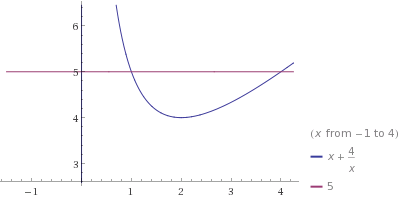Science:Math Exam Resources/Courses/MATH101/April 2008/Question 02 (c)/Solution 1
The first step to solve this problem is to understand what volume we are trying to compute.
The question states that there is a region bounded by the curves y=5 and y=x+4/x. For large values of x the second curve looks like the line y=x, but there is also a vertical asymptote at x=0. So it seems that it will indeed cross the horizontal line y=5 twice (as it dips down before going back up). We can compute where the intersections are by solving:
which is equivalent to
and has solutions x=1 and x=4. Then we want to know how far down the curve goes, so we look for its local minimum. We compute its derivative:
and hence see that it has two critical points, one at x=-2 and one at x=2. We are only interested in the local minimum which is at x=2. This should be enough details to have you be able to obtain the equivalent of the following picture:
This in particular shows that y=5 is bigger than y=x+4/x.
Now, consider a point x between 1 and 4. The distance from x to x=-1 is the radius of the cylindrical shell and is r=x+1. The height of the function at this point is the difference of the top function y=5 to the bottom function y=x+4/x which is 5-x-4/x. When we rotate, we travel a distance of (the circumference) and we are multiplying by . Thus, we have
Where each of the last four answers are equivalent and would be accepted as a final answer.






